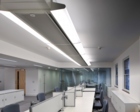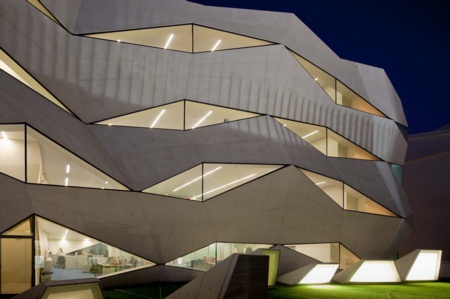The many facets of chilled ceilings and beams

David Leatherbarrow considers how radiant chilled ceiling and chilled beam solutions can help deliver the cooling performance required to combat the heat loads and provide for the demands of productive working environments in buildings today.
Specification of many air-conditioning products is based on performance criteria — with key factors such as minimising energy running costs and reducing carbon emissions balanced against this. Yet to maximise property value and lease-out opportunity, occupant comfort has become a major consideration, whilst answering demands for energy efficient solutions.
All buildings have different requirements, and it is the role of a design engineer to select the most cost-effective and energy-efficient solution to achieve legislative or ratings stipulations — and to answer specific occupant comfort needs. In addition, room-comfort solutions fitted now may need to accommodate future layout requirements, including demountable partitioning, and this is also a consideration at specification stage.
In recent years, radiant chilled ceilings have emerged as an alternative to traditional air-conditioning systems. These solutions radiate cooling downwards and provide quiet, draught-free comfort cooling.
Increased noise levels in any environment can affect workers’ productivity by creating an uncomfortable and disruptive workplace. The same is true for educational buildings, where the importance of good acoustics for a good learning environment has long been recognised.
From below, chilled-ceiling systems look the same as a suspended metal ceiling, but chilled-ceiling panels house a cooling element in the rear of the ceiling tile and use water as the cooling medium. The ‘coolth’ is provided by means of radiation (as opposed to convection), which means there is no perceptible air movement. Occupants and surfaces benefit from the cooling in the first instance, which subsequently leads to a reduction in the air temperature of the occupied space.
With the link between occupant comfort and productivity being a core consideration, chilled ceilings also have an advantage in being unobtrusive. They can free up valuable office space for occupation and use. This benefit is often overlooked, but is of increasing importance as space provision, particularly in offices, demands that the use of the floorplate is maximised for cost efficiencies to be realised.
Further, as refurbishment projects take centre stage, chilled ceilings can be installed with voids less than 100 mm deep because ductwork is not needed. This is particularly relevant when refurbishing buildings from the 1960s and 1970s, where space between floors and ceilings is at a premium.
Two projects illustrate this point.
SAS CoolCeil chilled ceilings were specified throughout the six floors of a prestigious development in the heart of Dublin’s central business district. Irish architects Burke Kennedy Doyle & Associates specified these chilled ceilings throughout the six floors. Homan O’Brien Associates was the M&E consultant for the project.
The existing building had a low floor-to-ceiling height compared with modern buildings, and the developers wanted to maximise the feeling of height within the space. An cooling solution was required to allow a finished floor-to-ceiling height of 2700 mm with only an 85 mm zone available below the coffered slab.

Similarly the headquarters building of Vodafone in Oporto, Portugal uses 2000 m2 of SAS International radiant chilled ceilings to deliver comfort cooling in the an energy-efficient way and minimise the building’s CO2 emissions, and for a flexible design choice.
Pedro Albuquerque, mechanical engineer for the HVAC project for Vodafone Oporto commented that in a building where façades guarantee a well controlled heat gain and loss, the installation of chilled ceilings arose as the choice for an ‘invisible’ cooling/heating air-treatment solution that was highly flexible in the planning of the inner space.
Chilled beams can also be installed with chilled ceilings. Passive beams use natural convection. As warm air rises in the occupied space, it is drawn through the beam, which is fitted with pipes carrying cooled water. The warm air is cooled before returning downwards into the space. Fresh air can be introduced via a floor-based ventilation system or ceiling diffusers. A passive chilled beam provides 130 W/m² cooling capacity whilst an active chilled beam provides 150 W/m².
With recent changes to Part L, where the regulations surrounding the limitation of solar gain in the Summer have been altered to allow for a more equal playing field between mechanically and naturally ventilated buildings, there is now room for innovation when looking at cooling options.
In another new head-office development in the UK, a chilled ceiling system from SAS International is combined with passive chilled beams at the building's perimeter to offset further solar gain. By having the perimeter beams separate from the actual ceiling panels, the system is able to offset solar loads that many other cooling systems cannot handle due to lack of cooling output.
Lighting, public-address systems, smoke detection, passive infra-red sensors and other building services can be integrated within a chilled ceiling or beam. Elements are manufactured to encompass each integrated service and ensure cooling outputs are not compromised.
The use of chilled beams or chilled ceilings shows that engineers can satisfy the thermal, aural and visual comfort of the occupants at the same time as providing a cost-effective and energy-efficient solution that will satisfy both occupants and developers.
David Leatherbarrow is with SAS International.









